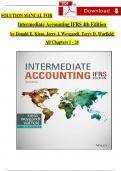SOLUTION MANUAL FOR Intermediate Accounting IFRS 4th Edition by Donald E. Kieso, Jerry J. Weygandt, Terry D. Warfield All Chapter s 1 - 24 Table of Contents 1. CHAPTER 1: Financial Reporting and Accounting Standards 2. CHAPTER 2: Conceptual Framework for Financial Reporting 3. CHAPTER 3: The Accounting Information System 4. CHAPTER 4: Income Statement and Related Information 5. CHAPTER 5: Statement of Financial Position and Statement of Cash Flows 6. CHAPTER 6: Accounting and the Time Value of Money 7. CHAPTER 7: Cash and Receivables 8. CHAPTER 8: Valuation of Inventories: A Cost -Basis Approach 9. CHAPTER 9: Inventories: Additional Valuation Issues 10. CHAPTER 10: Acquisition and Disposition of Property, Plant, and Equipment 11. CHAPTER 11: Depreciation, Impairments, and Depletion 12. CHAPTE R 12: Intangible Assets 13. CHAPTER 13: Current Liabilities, Provisions, and Contingencies 14. CHAPTER 14: Non -Current Liabilities 15. CHAPTER 15: Equity 16. CHAPTER 16: Dilutive Securities and Earnings per Share 17. CHAPTER 17: Investments 18. CHAPTER 18: Revenue Recognition 19. CHA PTER 19: Accounting for Income Taxes 20. CHAPTER 20: Accounting for Pensions and Postretirement Benefits 21. CHAPTER 21: Accounting for Leases 22. CHAPTER 22: Accounting Changes and Error Analysis 23. CHAPTER 23: Statement of Cash Flows 24. CHAPTER 24: Presentation and Disclo sure in Financial Reporting CHAPTER 1 Financial Reporting and Accounting Standards ASSIGNMENT CLASSIFICATION TABLE Topics Questions Concepts for Analysis 1. Global markets and financial reporting. 1, 2, 3, 4 4 2. Objective of financial reporting. 5, 6, 7, 8, 9, 10 2, 3 3. Standard -setting organizations. 11, 12, 13, 14, 15, 16, 17, 18 4. Financial reporting challenges. 19, 20, 21, 22, 23, 24, 25 ASSIGNMENT CHARACTERISTICS TABLE 1, 2, 3, 5, 6, 8, 9, 11 3, 7, 8, 10, 11, 12 Item Description Level of Difficulty Time (minutes) CA1.1 IFRS and standard -setting. Simple 5–10 CA1.2 IFRS and standard -setting. Simple 5–10 CA1.3 Financial reporting and accounting standards. Simple 15–20 CA1.4 Financial accounting. Simple 15–20 CA1.5 Need for IASB. Simple 15–20 CA1.6 IASB role in standard -setting. Simple 15–20 CA1.7 Accounting numbers and the environment. Simple 10–15 CA1.8 Politicalization of IFRS. Complex 15–20 CA1.9 Models for setting IFRS. Simple 10–15 CA1.10 Economic consequences. Moderate 10–15 CA1.11 Rule -making Issues. Complex 20–25 CA1.12 Financial reporting pressures. Moderate 25–35 ANSWERS TO QUESTIONS 1. World markets are becoming increasingly intertwined. The tremendous variety and volume of both exported and imported goods indicates the extensive involvement in international trade. As a result, the move towards adoption of international financial reporting standards has and will continue in the future. LO: 1, Bloom: K, Difficulty: Simple, Time: 3-5, AACSB: None, AICPA BB: None, AICPA FC: Reporting, AICPA PC: Communication 2. Financial accounting measures, classifies, and summarizes in report form those activities and that information which relate to the enterprise as a whole for use by parties both internal and external to a business enterprise. Managerial accounting also measures, classifies, and summarizes in report form enterprise activities, but the communication is for the use of internal, managerial parties, and relates more to subsystems of the entity. Managerial accounting is management decision -oriented and directed more toward product line, division, and profit center reporting. LO: 1, Bloom: K, Difficulty: Simple, Time: 3-5, AACSB: None, AICPA BB: None, AICPA FC: Reporting, AICPA PC: Communication 3. Financial statements generally refer to the four basic financial statements: statement of financial position, statement of comprehensive income (or income statement), statement of cash flows, and statement of changes in equity. Financial reporting is a bro ader concept; it includes the basic financial statements and any other means of communicating financial and economic data to interested external parties. LO: 1, Bloom: K, Difficulty: Simple, Time: 3-5, AACSB: None, AICPA BB: None, AICPA FC: Reporting, AICPA PC: Communication 4. If a company‘s financial performance is measured accurately, fairly, and on a timely basis, the right managers and companies are able to attract investment capital. To provide unreliable and irrelevant information leads to poor capital allocation which adversely affects the securities market. LO: 1, Bloom: K, Difficulty: Simple, Time: 3-5, AACSB: None, AICPA BB: None, AICPA FC: Reporting, AICPA PC: Communication 5. A single set of high quality accounting standards ensures adequate comparability. Investors are able to make better investment decisions if they receive financial information from a U.S. company that is comparable to an international competitor. LO: 2, Bloom: K, Difficulty: Simple, Time: 3-5, AACSB: None, AICPA BB: None, AICPA FC: Reporting, AICPA PC: Communication 6. The objective of general -purpose financial reporting is to provide financial information about the reporting entity that is useful to present and potential equity investors, lenders, and other creditors in maki ng decisions about providing resources to the entity. LO: 2, Bloom: K, Difficulty: Simple, Time: 3-5, AACSB: None, AICPA BB: None, AICPA FC: Reporting, AICPA PC: Communication 7. General -purpose financial statements provide financial reporting information to a wide variety of users. To be cost effective in providing this information, general -purpose financial statements provide at the least cost the most useful information possible. LO: 2, Bloom: K, Difficulty: Simple, Time: 3-5, AACSB: None, AICPA BB: None, AICPA FC: Reporting, AICPA PC: Communication 8. Shareholders, creditors, suppliers, employees, and regulators all use general -purpose financial statements. The primary user group is capital providers (shareholders and creditors). LO: 2, Bloom: K, Difficulty: Simple, Time: 3-5, AACSB: None, AICPA BB: None, AICPA FC: Reporting, AICPA PC: Communication 9. The proprietary perspective is not considered appropriate because this perspective generally does not reflect a realistic view of the financial reporting environment. Instead, the entity perspective is adopted which is consistent with the present business environment where most companies engaged in financial reporting have substance separate and distinct from their owners. LO: 2, Bloom: K, Difficulty: Simple, Time: 3-5, AACSB: None, AICPA BB: None, AICPA FC: Reporting, AICPA PC: Communication





